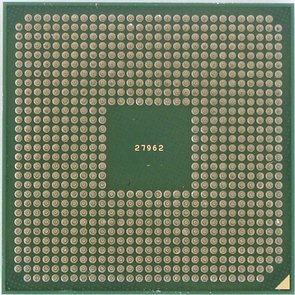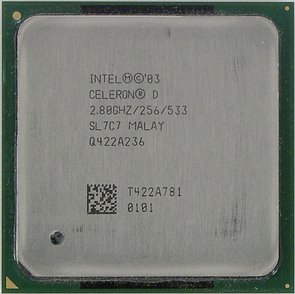 |
||
|
||
| ||
New CPUs: AMD Sempron and Intel Celeron D
AMD Sempron
With the launch of Duron Model 8 the Duron trademark seemingly had a second breath, but in fact it turned out a death-rattle. AMD decided to promote a new name, which from now on will be associated with the low end processors from the company – Sempron. However, it's not quite correct to say that Sempron replaces Duron: the latter models available on the market can be counted on the fingers of one hand and a whole year passed since Athlon 64 was launched. Thus most Athlon XP processors rated "below two thousand" are de facto low end AMD processors by price as well as by position. That's why it's junior Athlon XP that will be replaced by Sempron, later on it will start to replace top 32-bit models. Considering the above said, you will hardly be surprised to learn that a Sempron rated below 3000 is in fact a renamed Athlon XP. They are produced using the most economically effective core – 0.13µ manufactured Thoroughbred(-B). What concerns the cache size and bus frequency (the play that confused the ranking image of AMD processors), in this case they are quite decent, though not maximum possible for today: 256 KB L2 and 333 MHz FSB.    
A set of models ranked up to 3000+ is fixed and most likely will not be changed in future. However, the usual "as market requires" policy may lead to the launch of interesting products, including high ranked ones for Socket A. In the range "below 3000" everything is much more interesting, because this range is given away to Sempron processors based on the K8 architecture and represented so far by a single model 3100+. It was not only cut down in cache (also 256 KB L2), the Paris core also lacks the main marketing feature of 64-bit AMD processors – 64-bit calculations proper (x86-64 instruction set). Though even with the best will in the world you cannot say that common users will suffer from it, because at present they still have no opportunity to use those x86-64 instructions. And in future AMD can change its vision of necessary architectural Sempron features, especially as Cool'n'Quiet and bit NX functions (interesting to customers) were left intact. Note that the integrated memory controller in 3100+ is typical for Socket 754 – one-channel.   There are no questions about the infrastructure of Sempron 2200+ – 2800+ (100 units of gain in the rating correspond to the clock frequency increase by 83 MHz): the mainboard must be able to operate with 333 MHz FSB. Due to relatively low frequencies, the thermal emission in these Sempron models is within reasonable limits (62 W at the 90°C temperature limit), so there must not be problems with the choice of a cooling system either (the list of certified devices is rather large). 3100+ model is manufactured for Socket 754, that is for now it will prolong the life of this socket (in future there may appear Sempron for Socket 939). It goes without saying that any mainboard with this socket will do for these processors. Concerning Sempron ratings we can add that AMD introduced them to position models only within the series. It means that Sempron and Athlon XP/64 ratings, despite their seeming similarity, can be absolutely different from each other. (De facto rating of Athlon XP was graded according to Pentium 4 "Northwood", Athlon 64 rating - Pentium 4 "Prescott", and Sempron rating will be graded according to Celeron D.) This is logical, it resembles the latest Intel initiative to name processors using Processor Number, but even the most devoted AMD fans are sick and tired of this rating reshuffle! Intel Celeron D
In case of Intel, everything is simpler. Celeron D series replaces the Celeron series of desktop processors instead of complementing it. Replacement is actually not the word here, because "D" in this case stands for "desktop", that is Intel simply makes more apparent the distinction between desktop and mobile processors. When the newly named processors were launched, a new core happened to arrive, which on the analogy of "Willamette-128" and "Northwood-128" can be named "Prescott-256". Cutting down the capacity of the original Pentium 4 core is not limited to Cache L2 reduction to 256 KB: frequency of the system bus is fixed at 533 MHz (it'll be for long), Hyper-Threading is also disabled (let's hope that it's not disabled for good). From the market point of view, the separation of Intel series is very competent: all Pentium 4 processors, which can be currently found on shelves ("Northwood" with the bus at 533 MHz or higher), outscore any Celeron or Celeron D by at least one parameter. In future we'll surely see the launch of Celeron D for Socket 775, but at present the company will profitably sell a great number of cheap to produce 90nm chips, including chips with partially inoperative cache.   Celeron D processors will be initially marked with a processor number, at present there are the following options: 320 model – 2.4 GHz, 325 – 2.53 GHz, 330 – 2.67 GHz, 335 – 2.8 GHz. As we have already noted, all other parameters in these models are the same. What mainboards will support Celeron D? Obviously any mainboards, which are electrically compatible with Prescott processors and are based on the chipset supporting 533 MHz bus (from i845E/G to i915/925 and future i910GL/915GV, as well as corresponding competing products). By the way, the maximum thermal emission in all announced Celeron D models is 73 W at the maximum permissible temperature of 67°C. Performance testsTestbed configuration:
Software:
Test resultsI repeat that the objective of this article is to clear up (at least in general outline) the new market disposition after the launch of two new series of low end processors. We decided to omit the comparison of Celeron and Celeron D, because nothing interesting will come of it: new processors will always be faster than the old. But you cannot say that for sure about AMD products: the company made such a mess of its rating system, that even processors of the same series sometimes do not blend with the general table of ranks and outscore models with higher ratings. Now we have the following correspondence: Athlon XP 2400+ has a considerably higher frequency (by 333 MHz) but a lower bus frequency in comparison with Sempron of the same rating. Athlon XP 2800+ has almost nominal advantage over its "successor" in clock frequency, but it has a larger cache (Sempron 2800+ is similar to Athlon XP 2400+). We suggest that you puzzle out the three models rated 3100+ and higher on your own. So, it's interesting to clear up the position of this series, especially considering the fact that Sempron processors may be based on principally different architectures.
As we are to compare low end processors, it would be logical to confine ourselves in game tests to a video card, which is not very productive: it's easy to imagine a low end video card bought for a computer with a top processor, but the contrary situation is hardly ever possible. The editors decided to use a video card based on ATI Radeon 9600 Pro. Of course we could have taken another model or tested several video cards, the list of main contenders in this test could also have been edited till all is blue. But in our opinion, the existing results, which may fail to satisfy everybody, are still better than "a bird in the bush", which could have been caught in a couple of years. In much the same way the editors decided to choose the top mainboards (based on i865PE with PAT and NVIDIA nForce2 Ultra 400) for the testbeds, while the memory selected has unideal timings. Note that the results of a 3.4 GHz Pentium 4 are provided not for a direct comparison with low end models, but at multiple requests of our readers, who want to see "exactly how much they lose". When archiving with 7-Zip, CPU frequency plays an important role, and the
rating of Athlon XP is always noticeably weightier than Sempron rating.
Celeron D looks better than Sempron on the old core, but not than
the low end CPU based on K8. Duron can hardly be seen. Let's agree
that we compare Celeron D and Sempron taking into account their prices
at the time the article is published (read more details in the conclusions).
When archiving with WinRAR, Athlon XP and Sempron ratings are much closer,
Celeron D raises its positions, but Sempron-K8 breaks further away
from its chasers while Duron is increasingly lagging behind. Video encoding using the DivX codec is critical to the CPU clock frequency,
thus we witness here a benefit night of Celeron D, while Sempron processors
are steadily sliding down to the bottom part of the diagram. When we change the encoder to WMV9, all Celeron D processors slump down, the
other processors retaining their positions – obvious dependence
on the CPU architecture. (Interestingly, Pentium 4 "Prescott"
in this test confidently outscores Pentium 4 "Northwood"
– perhaps Celeron D has a small cache size for its core.) The third video encoding test is also critical to CPU frequency, its results
are somewhere in between. The less are the Sempron ratings, the more
confidently they lose to the equal rated Athlon XP, while Celeron
D models look better than the corresponding Semprons. When encoding MP3 almost everything is up to the frequency – here is
a real confusion of AMD ratings. But Celeron D processors do not profit
from high frequencies, it's their worst results – the Prescott
core is not a star in this test. Radeon 9600 Pro is quite enough to play Return to Castle Wolfenstein, that's
why we can clearly see the pure competition of CPUs. It's not hard
to notice how all Intel CPUs and low frequency Semprons "slump"
with the increase of resolutions and image quality. With all that,
the fps level remains high enough to consider the system results in
the heaviest mode to be the most interesting ones. In case of a cutting edge game Unreal Tournament 2003, we can see that in 1280x960x32 the speed is already limited by the video card. But it has absolutely no effect on the ranking of our contenders, Celeron D processors go at the tail of the procession outscoring only the distressful Duron. Athlon XP is again faster than "its" Sempron, but not much – about 100-200 rating units. Conclusions
Thus, two new series were launched. Fortunately, they do not require new chipsets and mainboards, giving an opportunity to assemble cheap enough and sufficiently productive systems from time-proved components.
At the moment this article was written Sempron 2400+ - 2800+ and Celeron D 320 - 335 could be put approximately on the level according to their price. In this case their performance evaluation will look like this: according to the test results Intel processors are better at video encoding and AMD processors – at games. Potentially very interesting model Sempron 3100+ stands by itself demonstrating an excellent performance level matching its rating. But it's difficult to draw any conclusions about its market prospects without the pricing info. Though the idea of popularizing K8 processors, even with disabled x86-64, looks attractive to us. And finally, note that on the whole Sempron ratings look rather credible, which allows to take processors of this series as somewhat slowed down Athlon XP with the same rating (the difference is clearly seen only in video encoding).
|